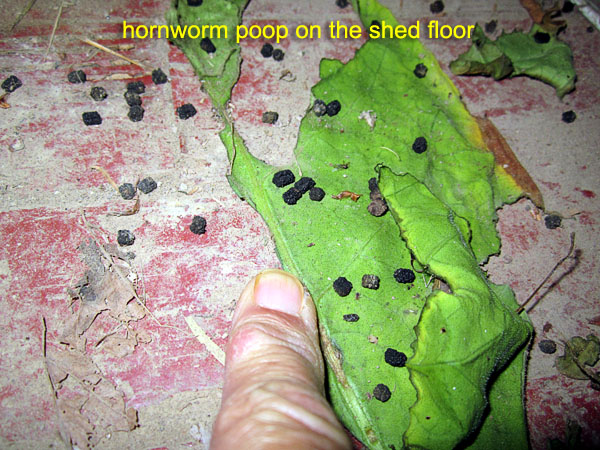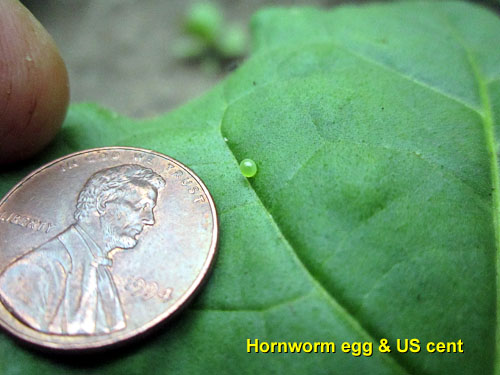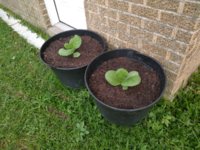You are using an out of date browser. It may not display this or other websites correctly.
You should upgrade or use an alternative browser.
You should upgrade or use an alternative browser.
GrowleyMonster's Grow Thread, 2022
- Thread starter GrowleyMonster
- Start date
GrowleyMonster
Creator of the Imperfecto
So, not really knowing what I was doing, I started priming as some of the lower lugs started turning. Unfortunately I saw reference to hands of tobacco that contained 30 to 40 leaves. That seemed a bit much but I bundled up hands of around a dozen leaves, which I now know is still too much for barn curing. Further, as they cured and shrank, a lot of leaves and entire hands just slipped right out of their ties. It took a while for me to get my tying routine down so I wouldn't find soggy piles of leaves on the floor. I ended up bundling only four large leaves or 6 smaller ones per hand, with rubber bands. No more leaves slipping out of their ties as stems shrink. Hung each of those hands on individual strings with just a clove hitch around the neck of the hand, so I could just tug on the bitter end to tighten, and ran the standing part through the middle of the hand. Tied these in pairs with one on one side of the rafter, one on the other. I also hung a bunch on the carport where there is more circulation and slightly less humidity, hoping to get a lighter color cure. Some of these I hung the same way. Some, I just split the hand and straddled them on a string passed between stanchions on the carport. There is a big wide overhang so they don't get any rain on them. The next big leaves I pick will get bundled in hands of just two leaves. Our humidity stays so high, I really don't see much advantage of more leaves per hand, and I want to keep the mold down.
I have probably picked about 25 lbs green weight so far, looks like I am about 1/3 harvested, this from around 100 plants. Cured weight, medium case, I guess maybe 5lb? If I get 15lb of bakky and at least a couple dozen wrapper leaf halves, I will be satisfied, but I think I will get a little better than that when it is all said and done.
Just checked the curing tobacco. The rubber bands are really doing the trick. NO leaves have fallen out of the rubberbanded hands. I was just about ready to start stringing individual leaves with a needle but this looks like the best way for me.
I have probably picked about 25 lbs green weight so far, looks like I am about 1/3 harvested, this from around 100 plants. Cured weight, medium case, I guess maybe 5lb? If I get 15lb of bakky and at least a couple dozen wrapper leaf halves, I will be satisfied, but I think I will get a little better than that when it is all said and done.
Just checked the curing tobacco. The rubber bands are really doing the trick. NO leaves have fallen out of the rubberbanded hands. I was just about ready to start stringing individual leaves with a needle but this looks like the best way for me.
Traditionally, tobacco leaves were tied into hands after they were color-cured. The purpose of tying into hands was for packing the cured tobacco into bales or hogsheads. Commercially, growers no longer tie their tobacco into hands.
Tying green leaves into hands is always a risky proposition. For me, stringing primed leaves onto a wire is far less work, and allows better air circulation during color-curing.
Bob
Tying green leaves into hands is always a risky proposition. For me, stringing primed leaves onto a wire is far less work, and allows better air circulation during color-curing.
Bob
GrowleyMonster
Creator of the Imperfecto
Gotcha. Baling wire is on the way! I will try that after it arrives in two days.Traditionally, tobacco leaves were tied into hands after they were color-cured. The purpose of tying into hands was for packing the cured tobacco into bales or hogsheads. Commercially, growers no longer tie their tobacco into hands.
Tying green leaves into hands is always a risky proposition. For me, stringing primed leaves onto a wire is far less work, and allows better air circulation during color-curing.
Bob
I use 17 gauge aluminum fence wire. Easy to work with, and no rusting.
Bob
Bob
GrowleyMonster
Creator of the Imperfecto
So, looks like I am about halfway through the harvest. Watching Ian closely. If we are going to get severe and sustained winds, I am stalk harvesting all that is left.
I thought maybe the air circulation in my curing barn / garage might be lacking, so I started curing on the carport. Unfortunately, all my big beautiful potential wrapper leaves got attacked by HORNWORMS! It never occurred to me that a pest that barely troubled my live plants, might make swiss cheese out of my harvested leaf! I had some leaves right at two feet long, and when I checked on them, full of fist size holes. The leaves that still had lots of green, I found worms on, bug fat ones, fat on the fruit of my labor. Was I pissed? WAS I! LOL! And I don't think my plants have any more leaves like that left in them. I get lots of 16" to 18" leaves, but no more two footers.
Stringing them on wire seems to be working nicely. Even better than the rubber bands. I tossed a few hands cured in the garage that got moldy, maybe a pound altogether. Most of the rest seem to have come out nice. Haven't smoked any of the crop yet. I have a few special leaves curing in the office, some that got nice and yellow on the stalk, and I will roll a couple of smokes from them to sample early. Honestly, I can't wait. My results yeah, coulda shoulda been so much better, but I got something and I think it was worthwhile. Next year I will be able to put what I learned to good use. I had planned to double my planting, but instead I am now leaning more toward FEWER plants, further apart, with more care given to them individually. As it stands now, I am going with 20 plants in the ground of each of four varieties:
CT Broadleaf
Moldovan 456
Piloto Cubano
Criollo 98
I am liking the Piloto and Criollo as a filler blend, so they are in, no question. It's gonna be a wrapper shootout between the CTBL and the Moldovan, which I am actually kind of excited about. The Moldovan looks like pretty good leaf, though I haven't had any in hand yet. One or the other, between that one and the CTBL, is going down. Let's see which one is the prettiest, palest, shiniest, easiest to roll, best burningest, and tastiest. The next year I might match the winner up against one of the Burleys. I roll mostly Imperfectos and I like a big wrapper so I can cut out a nice curly curvey "S" shape from it, and the big burleys throw some mighty big leaves, so they are potential contenders.
Got all my seed in except for the CTBL, and it is inbound. Got my seedling trays. Just waiting for the end of January to start another generation of baby bakkers here at Finca Growley. 80 well tended plants put in the ground at the right time of year, with the right sunlight, right irrigation, right fertilizer, right pest control, right support, picking, curing, like The Donald says, "It's gonna be HYOOOOOGE!"
I will have everything picked in a couple of weeks, all cured and in my tupperware aging bins in a couple of months. Pics then.
I thought maybe the air circulation in my curing barn / garage might be lacking, so I started curing on the carport. Unfortunately, all my big beautiful potential wrapper leaves got attacked by HORNWORMS! It never occurred to me that a pest that barely troubled my live plants, might make swiss cheese out of my harvested leaf! I had some leaves right at two feet long, and when I checked on them, full of fist size holes. The leaves that still had lots of green, I found worms on, bug fat ones, fat on the fruit of my labor. Was I pissed? WAS I! LOL! And I don't think my plants have any more leaves like that left in them. I get lots of 16" to 18" leaves, but no more two footers.
Stringing them on wire seems to be working nicely. Even better than the rubber bands. I tossed a few hands cured in the garage that got moldy, maybe a pound altogether. Most of the rest seem to have come out nice. Haven't smoked any of the crop yet. I have a few special leaves curing in the office, some that got nice and yellow on the stalk, and I will roll a couple of smokes from them to sample early. Honestly, I can't wait. My results yeah, coulda shoulda been so much better, but I got something and I think it was worthwhile. Next year I will be able to put what I learned to good use. I had planned to double my planting, but instead I am now leaning more toward FEWER plants, further apart, with more care given to them individually. As it stands now, I am going with 20 plants in the ground of each of four varieties:
CT Broadleaf
Moldovan 456
Piloto Cubano
Criollo 98
I am liking the Piloto and Criollo as a filler blend, so they are in, no question. It's gonna be a wrapper shootout between the CTBL and the Moldovan, which I am actually kind of excited about. The Moldovan looks like pretty good leaf, though I haven't had any in hand yet. One or the other, between that one and the CTBL, is going down. Let's see which one is the prettiest, palest, shiniest, easiest to roll, best burningest, and tastiest. The next year I might match the winner up against one of the Burleys. I roll mostly Imperfectos and I like a big wrapper so I can cut out a nice curly curvey "S" shape from it, and the big burleys throw some mighty big leaves, so they are potential contenders.
Got all my seed in except for the CTBL, and it is inbound. Got my seedling trays. Just waiting for the end of January to start another generation of baby bakkers here at Finca Growley. 80 well tended plants put in the ground at the right time of year, with the right sunlight, right irrigation, right fertilizer, right pest control, right support, picking, curing, like The Donald says, "It's gonna be HYOOOOOGE!"
I will have everything picked in a couple of weeks, all cured and in my tupperware aging bins in a couple of months. Pics then.
Those leaves can have tiny clusters of hornworm eggs on them that hatch after harvest and you begin curing. All of a sudden you have a hornworm wave that seemingly comes out of nowhere. Keep the floor clean under them and keep an eye out for their tiny manure pellets. Sometimes those droppings are the first sign of trouble if the worms are hiding inside the bunched leaves.

That's from 2017. It was from a single hornworm on a stalk-harvested plant.
Bob
EDIT:

GrowleyMonster
Creator of the Imperfecto
Yeah, there's worm poop. I figured that's what it was, when I saw it. I guess in the tobacco patch, predators keep the worm population down and minimize damage, maybe. I got to figure out some way to kill the worms or drive them off after picking. One thing I was doing when I first started picking, was washing my leaf. I sprayed them down with the hose and a fairly vigorous spray nozzle because the first prime of course was all lugs with bits of soil on them, and there was also a lot of debris from a nearby elderberry tree, grass clippings, and corn pollen. I stopped doing that after I got further up the stalks, and just brushed and shook the leaves good. I noticed that fresh picked leaves had a sticky, micro-hairy kind of texture, and after getting hosed off, it was all gone. I was concerned that I might be washing a lot of the yum off of the leaves, so I stopped. Maybe the spraying was knocking off the eggs and baby hornworms, and when I stopped doing that, they were able to make themselves right home on those big delicious green leaves? And I wonder how freezing the leaves would work, before curing. I might try that with a few leaves tomorrow or the next day. I am overdue for another harvesting session.
That's from 2017. It was from a single hornworm on a stalk-harvested plant.
Bob
EDIT:

This article discusses some of the effects of freezing green leaf and how to minimize damage. I wouldn't do it on purpose.And I wonder how freezing the leaves would work, before curing.
Similar threads
-
About Us
This forum is dedicated to promoting the American tobacco farmer and tobacco home growers across the globe. Whether you grow by the acre, in your backyard, or in pots, you should find valuable and accurate information here.We discuss any variety of tobacco, as well as numerous approaches to growing, harvesting, curing, and finishing your crop. Our members will attempt to provide experience-based answers to your questions.
-
Buy raw tobacco from our Sponsor - WLT


